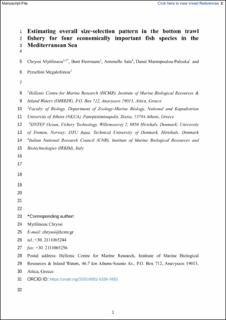| dc.contributor.author | Mytilineou, Chryssi | |
| dc.contributor.author | Herrmann, Bent | |
| dc.contributor.author | Sala, Antonello | |
| dc.contributor.author | Mantopoulou-Palouka, Danai | |
| dc.contributor.author | Megalofonou, Persefoni | |
| dc.date.accessioned | 2022-03-31T10:44:38Z | |
| dc.date.available | 2022-03-31T10:44:38Z | |
| dc.date.created | 2021-08-18T11:51:30Z | |
| dc.date.issued | 2021 | |
| dc.identifier.citation | Ocean and Coastal Management. 2021, 209 . | en_US |
| dc.identifier.issn | 0964-5691 | |
| dc.identifier.uri | https://hdl.handle.net/11250/2988796 | |
| dc.description.abstract | The management of multispecies fisheries, such as the Mediterranean bottom trawl fishery, is always a challenge. However, information on gear selectivity and discards has been studied separately so far. In this paper, the overall size-selection pattern by the trawl codend in the sea and by the fisher onboard the vessel is investigated for four commercially important fish species, Mullus barbatus, Mullus surmuletus, Pagellus erythrinus and Lophius budegassa, using different codends. For each species, the selection model used offered the possibility to simultaneously describe the escape, discard, and landing probability. The results, useful for fisheries management, showed that the codend made of 40 mm diamond meshes was always detrimental for the stocks. The 40 mm square meshes codend compared to that of 50 mm diamond meshes was more appropriate for the sustainability of both Mullus species, providing also a lawful catch along with greater compliance to the rules fisher behaviour, negligible discards and the lowest possible economic losses for the fisher. None of the codends was effective for P. erythrinus in achieving the minimum conservation reference size (MCRS) of the species. All codends were harmful to L. budegassa as the majority of juveniles were retained in the codend, resulting in negligible escapees, a high discard probability, and landings of a size much lower than the length at first maturity of the species. Further studies are needed to be conducted in the future for other species, since the trawl fishery in the Mediterranean is a multi-species fishery. | en_US |
| dc.language.iso | eng | en_US |
| dc.publisher | Elsevier | en_US |
| dc.rights | Attribution-NonCommercial-NoDerivatives 4.0 Internasjonal | * |
| dc.rights.uri | http://creativecommons.org/licenses/by-nc-nd/4.0/deed.no | * |
| dc.subject | Blackbellied anglerfish | en_US |
| dc.subject | Common pandora | en_US |
| dc.subject | Mullet | en_US |
| dc.subject | Discards | en_US |
| dc.subject | Size selection | en_US |
| dc.title | Estimating overall size-selection pattern in the bottom trawl fishery for four economically important fish species in the Mediterranean Sea | en_US |
| dc.type | Peer reviewed | en_US |
| dc.type | Journal article | en_US |
| dc.description.version | acceptedVersion | en_US |
| dc.rights.holder | This is the authors’ accepted and refereed manuscript to the article. This manuscript version is made available under the CC-BY-NC-ND 4.0 license | en_US |
| dc.source.pagenumber | 13 | en_US |
| dc.source.volume | 209 | en_US |
| dc.source.journal | Ocean and Coastal Management | en_US |
| dc.identifier.doi | 10.1016/j.ocecoaman.2021.105653 | |
| dc.identifier.cristin | 1926923 | |
| dc.source.articlenumber | 105653 | en_US |
| cristin.ispublished | true | |
| cristin.fulltext | postprint | |
| cristin.qualitycode | 1 | |

